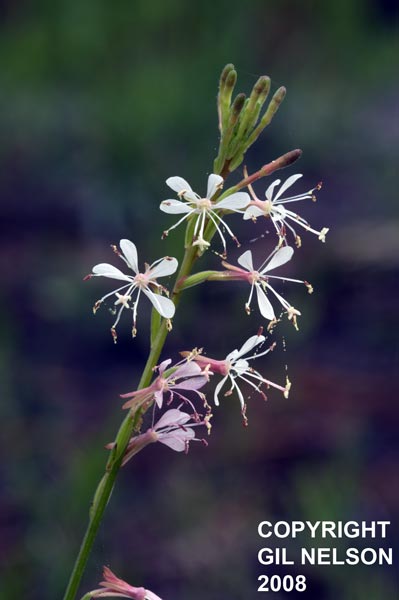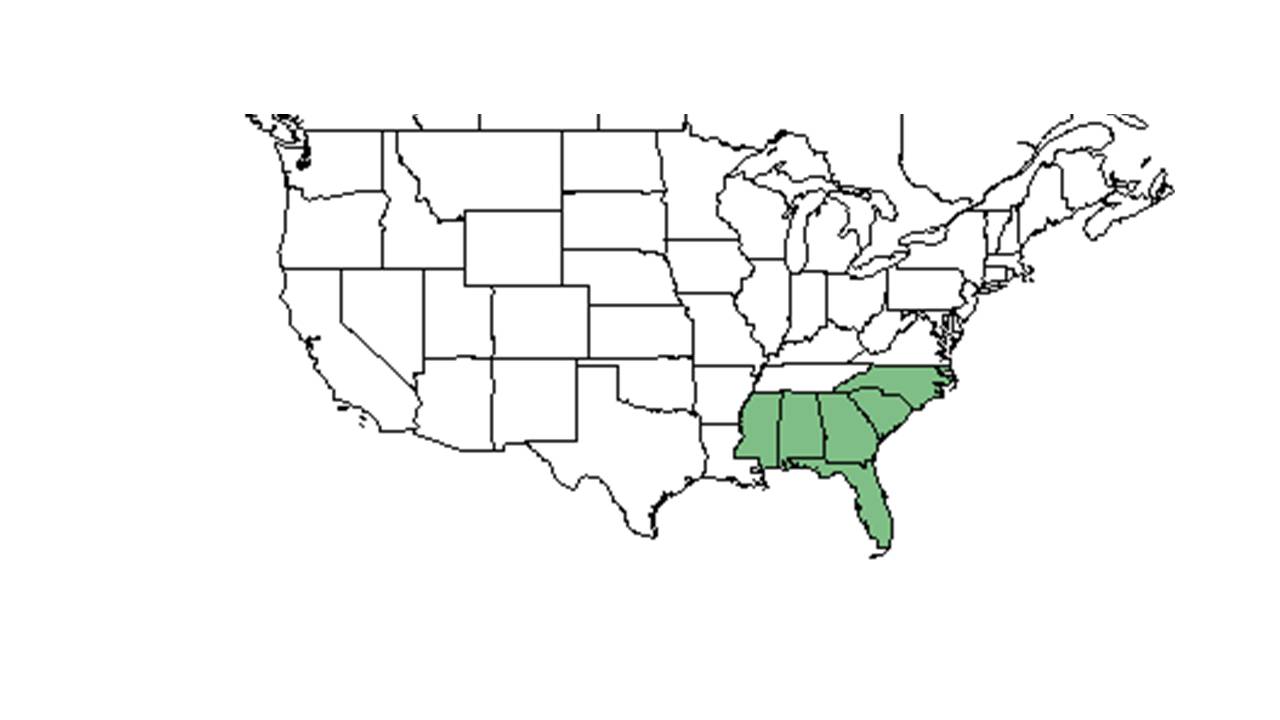Difference between revisions of "Oenothera simulans"
(→Conservation and Management) |
Krobertson (talk | contribs) |
||
| Line 25: | Line 25: | ||
==Description== | ==Description== | ||
<!-- Basic life history facts such as annual/perrenial, monoecious/dioecious, root morphology, seed type, etc. --> | <!-- Basic life history facts such as annual/perrenial, monoecious/dioecious, root morphology, seed type, etc. --> | ||
| − | Observed to be an abundant weedy species in roadside sods | + | Observed to be an abundant weedy species in roadside sods. "ref name="FSU Herbarium">Florida State University Robert K. Godfrey Herbarium database. URL: [http://herbarium.bio.fsu.edu http://herbarium.bio.fsu.edu]. Last accessed: June 2014. Collectors: Robert K. Godfrey, Loran C. Anderson, Robert Kral, Gwynn W. Ramsey, Richard S. Mitchell, Cecil R Slaughter, Marc Minno, Mary Atkinson, O. Lakela, R. W. Long, Dorothy Laker, Andre F. Clewell, Robert Blaisdell, Jane Brockmann, Sidney McDaniel, D. B. Ward, Robert J Lemaire, Ira L. Wiggins, Dorothy B. W D. B. Creager,iggins, Elmer C. Prichard, George R. Cooley, Carroll E. Wood, Jr., Kenneth A. Wilson, Bian Tan, L. Baltzell, S. W. Leonard, R. Komarek, Leon Neel, R. F. Doren, and Annie Schmidt. States and Counties: Florida: Alachua, Bradford, Brevard, Citrus, Columbia, Duval, Franklin, Gadsden,Hamilton, Hardee, Hernando, Hillsborough, Indian River, Jackson, Lake, Lee, Leon, Levy, Liberty, Madison, Monroe, Orange, Palm Beach, Sarasota, St Johns, Sumter, Taylor, Union, Volusia, and Wakulla. Georgia: Thomas. Texas: Hardin.</ref> |
| − | "Usually coarse, branched annuals or perennials. Leaves mostly alternate. Inflorescence terminal, spike-like with or without axillary branches from upper leaves or bracts. Petals white to pink; stigmas 3-4 lobed. Fruit woody, indehiscent." | + | "Usually coarse, branched annuals or perennials. Leaves mostly alternate. Inflorescence terminal, spike-like with or without axillary branches from upper leaves or bracts. Petals white to pink; stigmas 3-4 lobed. Fruit woody, indehiscent." <ref name="Radford et al 1964">Radford, Albert E., Harry E. Ahles, and C. Ritchie Bell. Manual of the Vascular Flora of the Carolinas. 1964, 1968. The University of North Carolina Press. 754-6. Print.</ref> |
| − | "Plant to 2m tall, stem strigose. Leaves narrowly elliptic or lanceolate, strigillose to glabrous, to 8 cm long and 1 cm wide, reduced upward, frequently fascicled, acute, remotely denticulate or serrulate, the basal sinuate; sessile. Spikes usually branched, main branch to 3 dm long, strigose; bracteoles caduceus. Sepals 3.5-6 mm long; petals 2.5-3 mm long; anthers 1.2-1.5 mm long; styles exserted ca. 5.5 mm. fruits acutely 3-4 angled, sides concave, canescent, ovoid, 6-8 mm long, 2-3 mm broad; pedicels 1-2 mm long." | + | "Plant to 2m tall, stem strigose. Leaves narrowly elliptic or lanceolate, strigillose to glabrous, to 8 cm long and 1 cm wide, reduced upward, frequently fascicled, acute, remotely denticulate or serrulate, the basal sinuate; sessile. Spikes usually branched, main branch to 3 dm long, strigose; bracteoles caduceus. Sepals 3.5-6 mm long; petals 2.5-3 mm long; anthers 1.2-1.5 mm long; styles exserted ca. 5.5 mm. fruits acutely 3-4 angled, sides concave, canescent, ovoid, 6-8 mm long, 2-3 mm broad; pedicels 1-2 mm long." <ref name="Radford et al 1964"/> |
==Distribution== | ==Distribution== | ||
| Line 35: | Line 35: | ||
===Habitat=== <!--Natural communities, human disturbed habitats, topography, hydrology, soils, light, fire regime requirements for removal of competition, etc.--> | ===Habitat=== <!--Natural communities, human disturbed habitats, topography, hydrology, soils, light, fire regime requirements for removal of competition, etc.--> | ||
| − | This species can be found in marshy depressions surrounded by live oak hammocks, pine-oak woodlands, grass and succulent cover, beach hammocks, longleaf pine forests, old fields, along oak scrub edges, and bordering salt marshes | + | This species can be found in marshy depressions surrounded by live oak hammocks, pine-oak woodlands, grass and succulent cover, beach hammocks, longleaf pine forests, old fields, along oak scrub edges, and bordering salt marshes. <ref name="FSU Herbarium"/> ''O. simulans'' has been observed to grow in moist loamy, loose, and silty sands in open areas. <ref name="FSU Herbarium"/> This species is "one of the most aggressive pioneers in disturbed areas" such as plowed fire lanes, along roadsides, vacant lots, clear cut pinewoods, and along fence rows. <ref name="FSU Herbarium"/> Associated species includes ''Pinus, Quercus, Papaya, Forestiera, Bumelia, Eugenia, Piscidia, Agave, Yucca, Juniperus, Sabal, Bumelia lanuginosa, Crateagus floridana, Pinus elliottii, Myrica cerifera, Pinus palustris,'' and ''Conzya.'' <ref name="FSU Herbarium"/> |
===Phenology=== <!--Timing off flowering, fruiting, seed dispersal, and environmental triggers. Cite PanFlora website if appropriate: http://www.gilnelson.com/PanFlora/ --> | ===Phenology=== <!--Timing off flowering, fruiting, seed dispersal, and environmental triggers. Cite PanFlora website if appropriate: http://www.gilnelson.com/PanFlora/ --> | ||
| − | This species has been observed flowering from March through October and Fruiting March through November | + | This species has been observed flowering from March through October and Fruiting March through November. <ref name="FSU Herbarium"/> |
<!--===Seed dispersal===--> | <!--===Seed dispersal===--> | ||
| Line 45: | Line 45: | ||
===Fire ecology=== <!--Fire tolerance, fire dependence, adaptive fire responses--> | ===Fire ecology=== <!--Fire tolerance, fire dependence, adaptive fire responses--> | ||
| − | This species has been found in areas of open burned pine-oak woodlands | + | This species has been found in areas of open burned pine-oak woodlands. <ref name="FSU Herbarium"/> |
<!--===Pollination===--> | <!--===Pollination===--> | ||
| Line 55: | Line 55: | ||
==Photo Gallery== | ==Photo Gallery== | ||
==References and notes== | ==References and notes== | ||
| − | |||
| − | |||
| − | |||
Revision as of 18:09, 3 August 2016
| Oenothera simulans | |
|---|---|

| |
| Photo taken by Gil Nelson | |
| Scientific classification | |
| Kingdom: | Plantae |
| Division: | Magnoliophyta - Flowering plants |
| Class: | Magnoliopsida – Dicotyledons |
| Order: | Myrtales |
| Family: | Onagraceae |
| Genus: | Oenothera |
| Species: | O. simulans |
| Binomial name | |
| Oenothera simulans Michx. | |

| |
| Natural range of Oenothera simulans from USDA NRCS Plants Database. | |
Common name: southern beeblossom
Contents
Taxonomic notes
Synonym: Gaura angustifolia Michaux; Gaura angustifolia var. angustifolia
Description
Observed to be an abundant weedy species in roadside sods. "ref name="FSU Herbarium">Florida State University Robert K. Godfrey Herbarium database. URL: http://herbarium.bio.fsu.edu. Last accessed: June 2014. Collectors: Robert K. Godfrey, Loran C. Anderson, Robert Kral, Gwynn W. Ramsey, Richard S. Mitchell, Cecil R Slaughter, Marc Minno, Mary Atkinson, O. Lakela, R. W. Long, Dorothy Laker, Andre F. Clewell, Robert Blaisdell, Jane Brockmann, Sidney McDaniel, D. B. Ward, Robert J Lemaire, Ira L. Wiggins, Dorothy B. W D. B. Creager,iggins, Elmer C. Prichard, George R. Cooley, Carroll E. Wood, Jr., Kenneth A. Wilson, Bian Tan, L. Baltzell, S. W. Leonard, R. Komarek, Leon Neel, R. F. Doren, and Annie Schmidt. States and Counties: Florida: Alachua, Bradford, Brevard, Citrus, Columbia, Duval, Franklin, Gadsden,Hamilton, Hardee, Hernando, Hillsborough, Indian River, Jackson, Lake, Lee, Leon, Levy, Liberty, Madison, Monroe, Orange, Palm Beach, Sarasota, St Johns, Sumter, Taylor, Union, Volusia, and Wakulla. Georgia: Thomas. Texas: Hardin.</ref>
"Usually coarse, branched annuals or perennials. Leaves mostly alternate. Inflorescence terminal, spike-like with or without axillary branches from upper leaves or bracts. Petals white to pink; stigmas 3-4 lobed. Fruit woody, indehiscent." [1]
"Plant to 2m tall, stem strigose. Leaves narrowly elliptic or lanceolate, strigillose to glabrous, to 8 cm long and 1 cm wide, reduced upward, frequently fascicled, acute, remotely denticulate or serrulate, the basal sinuate; sessile. Spikes usually branched, main branch to 3 dm long, strigose; bracteoles caduceus. Sepals 3.5-6 mm long; petals 2.5-3 mm long; anthers 1.2-1.5 mm long; styles exserted ca. 5.5 mm. fruits acutely 3-4 angled, sides concave, canescent, ovoid, 6-8 mm long, 2-3 mm broad; pedicels 1-2 mm long." [1]
Distribution
Ecology
Habitat
This species can be found in marshy depressions surrounded by live oak hammocks, pine-oak woodlands, grass and succulent cover, beach hammocks, longleaf pine forests, old fields, along oak scrub edges, and bordering salt marshes. [2] O. simulans has been observed to grow in moist loamy, loose, and silty sands in open areas. [2] This species is "one of the most aggressive pioneers in disturbed areas" such as plowed fire lanes, along roadsides, vacant lots, clear cut pinewoods, and along fence rows. [2] Associated species includes Pinus, Quercus, Papaya, Forestiera, Bumelia, Eugenia, Piscidia, Agave, Yucca, Juniperus, Sabal, Bumelia lanuginosa, Crateagus floridana, Pinus elliottii, Myrica cerifera, Pinus palustris, and Conzya. [2]
Phenology
This species has been observed flowering from March through October and Fruiting March through November. [2]
Fire ecology
This species has been found in areas of open burned pine-oak woodlands. [2]